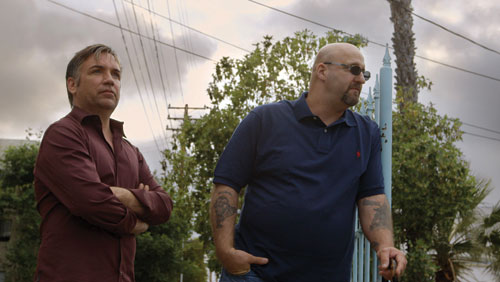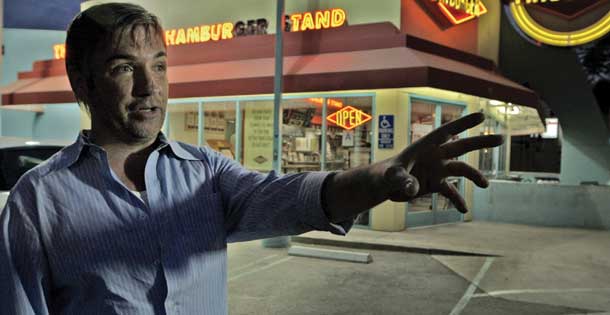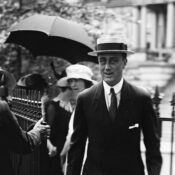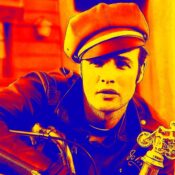Tim Zaal had also made a name for himself. By his mid-20s he had risen to prominence in the white supremacist movement, culminating in 1989 with an arrest for assault with a deadly weapon and civil rights violations. After a very public trial, he earned a year in the county jail. But prison only hardened him further. “I thought I was doing my time because of the color of my skin,” says Tim. “In my mind I was a political prisoner.”
At 26 when he got out of jail, Tim was a celebrity skinhead, spreading propaganda and hate. But he still heard that scream. “Not knowing whether I killed him was killing me,” he says. “Whenever I had a situation arise where I could have really hurt someone, I would hear that girl screaming and remember that kid, and it would stop me. Maybe it saved a few lives.”

Source: FacingFearMovie.com
When Tim’s son was born, something started to change inside him. Or maybe it was when he began to come into contact with people outside his insular world. After prison, he learned to be an electrician. He began meeting people of different races, creeds, and lifestyles. It surprised him that these “others” were kind to him. “I had it in my head that all nonwhites were against me, against the white race,” says Tim. “But the more exposure I had to them, the more that changed.”
Then one day in a grocery store his son, then just 2 1/2 years old, used the N-word in the presence of a black man, and, to his surprise, Tim felt ashamed. It was shortly afterward that he quit the white supremacist movement. A few years went by, and then he was introduced through a new friend he had met in the Rockabilly music scene to a Jewish woman. They fell in love and married a few years later. As his turnaround became complete, he decided he needed to do something to make up for his years of crime and misconduct. “I wrote a letter of apology to the Simon Wiesenthal Center’s Museum of Tolerance in Los Angeles, an anonymous letter,” says Tim. “But that was not enough for me. I needed to do more.”
He worked up his courage and called the museum, telling senior researcher Rick Eaton about his past. To his surprise, Eaton offered him a job speaking to schoolchildren. “It was the scariest thing I ever did,” says Tim. “But the kids really responded, and it made a difference. And so I kept doing it.”
As fate would have it, soon after, another man walked through the museum doors and asked for a job. It was Matthew.
Prompted by the death of Matthew Shepard–the young University of Wyoming student who was tortured and murdered in 1998 because he was gay–Matthew Boger realized he needed to tell his own story. “Matthew Shepard’s voice had been silenced,” says Matthew. “But mine was not, and there had to be a reason.”
Working first as a tour guide (and eventually becoming manager of operations) at the Museum of Tolerance, Matthew quickly learned about Tim’s past affiliations and was intrigued. “I wanted to understand the mind-set of someone like the man who beat me.”
Matthew invited Tim to speak to a school that had a nascent white supremacist group. That sparked a deeper conversation about their pasts, and they learned that they used to frequent the same places in Hollywood, including the hot dog stand. “As soon as he mentioned Okie’s Dog, I froze,” says Matthew. “There was a moment when we both knew who the other one was. But then he was the courageous one who said, ‘I was the one who led the attack.’”
It was, at first, too much to process. “I shut down,” says Matthew. “I was overwhelmed by so many mixed emotions. I mean here was this guy who was working with kids and had clearly reformed. And yet this was the kid whom I remembered beating me and high-fiving his friends about it.”
Matthew and Tim kept their distance from each other for a couple of days. But then Matthew went back for more. “I had to know why,” says Matthew. “And I give Tim so much credit for having the courage to explain it to me.”
Tim described that night in stark and vivid detail, but the unemotional way he related the events was at first troubling to Matthew. Tim explains: “It was very matter of fact for me. On the inside there was huge relief that he wasn’t dead. But I try not to be emotional because I separate myself psychologically from the person I used to be back then. I have to in order to stay sane.”
Become a Saturday Evening Post member and enjoy unlimited access. Subscribe now



